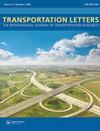基于混合山瞪羚优化器增强长短期记忆模型的人行横道行为预测分类
IF 3.3
3区 工程技术
Q2 TRANSPORTATION
Transportation Letters-The International Journal of Transportation Research
Pub Date : 2025-07-03
DOI:10.1080/19427867.2024.2404358
引用次数: 0
摘要
本文提出了一种混合山瞪羚优化器-长短期记忆(HMGO-LSTM)模型,以解决无信号人行横道上行人与车辆相互作用的安全问题。该模型将混合山羚优化器(HMGO)算法与长短期记忆(LSTM)网络相结合,使用HMGO作为LSTM超参数优化器。使用马鞍山人行横道和机动车道口的真实数据集对模型进行训练和评估。将HMGO-LSTM模型与k -最近邻(KNN)、随机森林(RF)和遗传算法-反向传播(GA-BP)等传统分类器进行了比较。结果表明,HMGO-LSTM模型在预测行人-车辆交互行为方面优于这些分类器,获得了更高的分类精度和F1分数。该模型还优化了十字路口的安全间隔,从而给出了新的限速建议。总体而言,HMGO-LSTM模型为管理和设计更安全的行人和车辆交叉口提供了坚实的理论基础。本文章由计算机程序翻译,如有差异,请以英文原文为准。
Predictive classification of pedestrian-vehicle crossing behaviors using a hybrid mountain gazelle optimizer-enhanced Long Short-Term Memory model
This paper addresses the safety issues of pedestrian-vehicle interactions at unsignalized pedestrian crossings by proposing a Hybrid Mountain Gazelle Optimizer-Long Short-Term Memory (HMGO-LSTM) model. The proposed model combines the Hybrid Mountain Gazelle Optimizer (HMGO) algorithm with a Long Short-Term Memory (LSTM) network, using HMGO as an LSTM hyperparameter optimizer. Real-world datasets of pedestrian and vehicle crossings from Ma’anshan were used to train and evaluate the model. The HMGO-LSTM model was compared with traditional classifiers such as K-Nearest Neighbors (KNN), Random Forest (RF), and Genetic Algorithm-Backpropagation (GA-BP). The results show that the HMGO-LSTM model outperforms these classifiers in predicting pedestrian-vehicle interaction behaviors, achieving higher classification accuracy and F1 score. The model also optimizes safety intervals for crossings, leading to new speed limit recommendations. Overall, the HMGO-LSTM model provides a robust theoretical foundation for managing and designing safer pedestrian and vehicle crossings.
求助全文
通过发布文献求助,成功后即可免费获取论文全文。
去求助
来源期刊

Transportation Letters-The International Journal of Transportation Research
TRANSPORTATION SCIENCE & TECHNOLOGY-
CiteScore
6.40
自引率
14.30%
发文量
79
审稿时长
>12 weeks
期刊介绍:
Transportation Letters: The International Journal of Transportation Research is a quarterly journal that publishes high-quality peer-reviewed and mini-review papers as well as technical notes and book reviews on the state-of-the-art in transportation research.
The focus of Transportation Letters is on analytical and empirical findings, methodological papers, and theoretical and conceptual insights across all areas of research. Review resource papers that merge descriptions of the state-of-the-art with innovative and new methodological, theoretical, and conceptual insights spanning all areas of transportation research are invited and of particular interest.
 求助内容:
求助内容: 应助结果提醒方式:
应助结果提醒方式:


